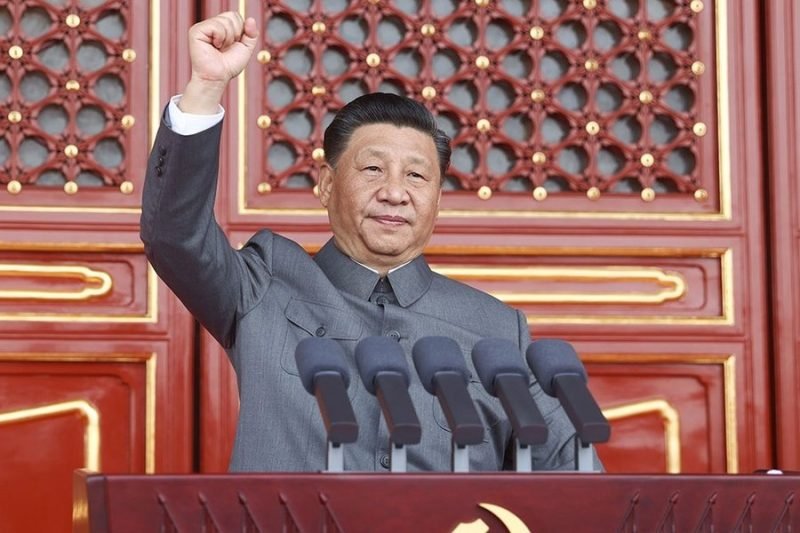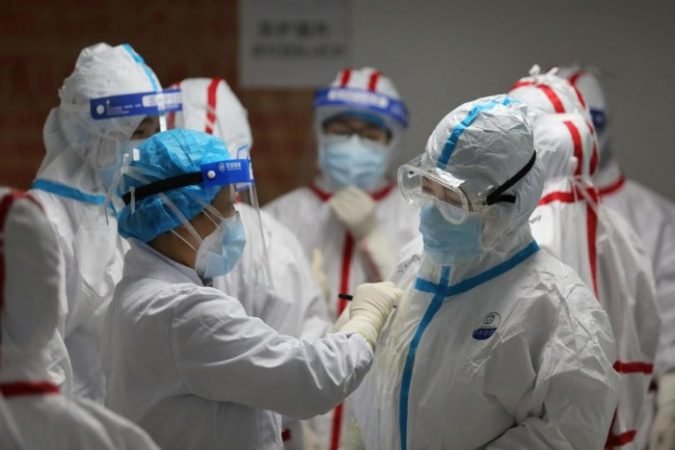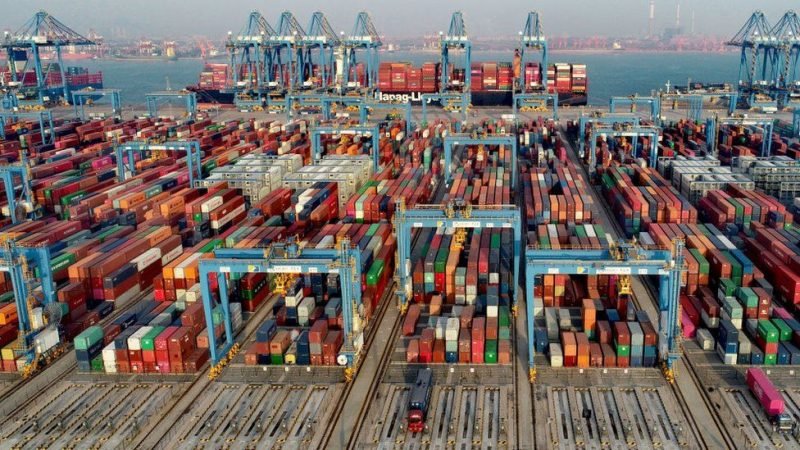China’s rise in the pandemic and post pandemic world order

Introduction:
“The Chinese use two brush strokes to write the word ‘crisis’. One brush stroke stands for danger; the other for opportunity. In a crisis, be aware of the danger, but also recognise the opportunity”. (John F Kennedy). History taught us all about the Chinese expansionist mindset and how they act after a major crisis or event, such as after the Vietnam War or following the US forces withdrawal from the Philippines when the territory was expanded in the South China Sea. And in the 21st century, we are faced with what happens in a post-COVID-19 world.
In Mandarin, ‘crisis’ is called ‘weiji’, wherein ‘wei’ stands for ‘danger’, while ‘ji’ stands for ‘incipient moment’, meaning a crucial point when something begins to change. While the world economy had a major setback in all fields- from tourism to education, to the service, agriculture and automobile to name a few and countries around the world are still recovering from the huge economic setback, while still battling the disease in every possible way they can, such is not the case for China.
Despite being the place of origin of the deadly virus that has taken millions of lives across the world, it is considered an exception. China has successfully navigated its path to success and economic recovery amidst the crisis, while also making its influence reach every corner of the world by either expansion, investment and diplomatic strategies. The paper, therefore, will study China’s foreign policy during the pandemic and how it paved its way to success. The question that will be answered through the paper is if the challenges faced during the pandemic and in the post-pandemic world will lead to a Chinese boom or fall in the global arena. Further, the paper will touch upon the long term possibilities of the Chinese global world order, overpowering the liberal western order.
China and the pandemic-
Economic globalization, with its increasing flow of trade, capital and labour, has made the world smaller and proliferated the virus flow across the globe in no time. Consequently, borders were blocked and economies shut, in turn disrupting the global supply chains and business continuity across the globe. Soon, the notion of self-reliance, economic detachment and a transition to self-developed value chains were being practised everywhere, leading to Global Value Chain (CVG) instability.
As the world’s largest manufacturing economy, China was struck with many challenges in the beginning of the pandemic.
- The US-China trade war in the pre pandemic world exacerbated the economic situation of China towards economic instability with the outbreak of Covid-19. The country’s exports account for almost 20% of its GDP, indicating its deep integration into the GVCs (UN Comtrade Database, 2020). A 1.5% annual drop was seen as a result of the trade war in 2019, totalling $4.1435.8 trillion in value of China’s trade with the US (Front Public Health, 2021).
- Economic downfall of other countries led to economic stagnation for China. The United States, European Union and Japan, the major trade partners of China, suffered heavily from the pandemic, making the global demand for Chinese capital goods and intermediate goods suffer a significant negative shock. The initial outbreak of the pandemic resulted in a sharp fall of Chinese exports as well as break of the value chains.

However, China managed to log 2.3 percent growth for 2020, becoming the only major economy that grew during a year when the virus exacted a devastating global toll. According to the National Statistics Bureau, ‘China’s gross domestic product rose 6.5 percent during the fourth quarter of 2020, exceeding the 6 percent pace at the end of 2019 before the coronavirus took hold. China’s GDP surpassed a milestone in 2020, topping 100 trillion yuan, or about $15 trillion’. (Gerry Shih, 2020). According to Chinese officials, exports hit an all-time high of $2.6 trillion in 2020. Despite a bitter trade war with the US, China’s trade surplus with the superpower reached a record $316.9 billion in the year 2020.
Reasons being China’s strategic planning in terms of diplomacy, expansion and investment as follows-
- Chinese Covid-19 diplomacy:
Covid-19 is said to be a blessing in disguise for China as it brought unprecedented opportunity to intensify its international influence and engage in a “covid-19 diplomacy” by making strategic moves to strengthen existing relationships, whilst forging new ones in the international diaspora. But how did it do so?
The notion of “no strings attached” is a non-existent concept in international politics as nothing comes without repercussions. Citizens of all countries were struggling and the healthcare system increasingly collapsing, making the world see how medically unprepared everyone was. In such a situation, the global public health crisis being marked as an opportunity; Beijing readily started making provisions for the supply of medical aid and vaccinations across the globe in exchange for asking the recipient countries to defend Chinese stances on issues. Even though it was projected as donations, 99 percent of its personal protective equipment (PPE) were actually sold. It was a win-win situation and a great diplomatic move.
However, while it was a smart move that earned Beijing goodwill and influence among its peripheral middle-income countries like Kyrgyzstan, Cambodia, Mongolia, Indonesia and among a few sub-Saharan African countries like Comoros, Zimbabwe; it was not deemed victorious with the wealthy democratic countries. The diplomacy being bilateral in approach and a non-egalitarian way of dealing, catering to only middle-income countries and leaving the poor countries vulnerable, limited Beijing’s reach and its representation of being a benevolent guarantor of global public health.
- Medical advancement:
China’s early response and quick mobilization ability made it come out stronger during the world’s toughest battle. Although its initial lockdown in Wuhan was controversial, it later was accepted by all as the only correct way to curb the spread.
The establishment of its medical treatment principles known as the ‘four earlies’- early detections, early reporting, early quarantine and early treatment, proved highly beneficial. Within 10 days, two intensive hospital cares were built, along with man makeshift hospitals.
Moreover, Chinese scientists were amongst the first to publish gene-sequencing information and other papers to be shared globally. High-tech methods such as 5g and others helped with remote diagnosis and in terms of epidemic prevention and control, big data, artificial intelligence, drones and mobile phones provided substantial assistance to anti-pandemic measures.

- Global expansionism:
China’s expansion and influence, also known as the ‘Salami Slicing Policy’ is not only limited to the Indo-China border, but also the whole of the Indian Ocean, the South China Sea, Taiwan, Philippines, Indonesia and Malaysia to name a few.
As told by Shrikanth Kondapalli, Professor of Chinese Studies at the Delhi-based Jawaharlal Nehru University, “Chinese expansionism was always there. The pandemic has acted as an instrument. In October 2017, this policy was debated and decided upon at the Chinese Communist Party’s meeting of the National Congress, namely that China seeks to be a global power and intends to assume centre stage, thereby becoming a leader for everyone to follow. The Party Congress issued directions and COVID-19 has only benefited Beijing is looking to achieve this goal because the world has been busy dealing with the pandemic, so China began to fulfil the goals it set in 2017.” (European Security and Defence, 2020).
China has always ensured to win without fighting a war. Its use of force is driven by deception, concealment and surprise- from the 1988 Johnson Reef seize and 1995 Mischief Reed, to occupancy of Scarborough Shoal in 2012 and finally Ladakh in 2020. The map of South China Sea also has been changed and influenced heavily without any firing or incursion of any international costs. Similar is the case with its growing infrastructural projects under the Belt and Road Initiative that has made almost the whole world come under its gambit. China has its ways clear. Although it seems to deceive and cunning by others, it is striking positively for itself and considered as smart moves to get what it wants without playing the offensive card.
- Debt trap diplomacy:
As told by John Adams, “There are two ways to conquer and enslave a country: One is by the sword; the other is by debt.” China, choosing the second path, has embraced colonial-era practices and rapidly emerged as the world’s biggest official creditor, marking an era of Chinese creditor imperialism.
In order to gain swift political and economic ascendency across the globe, China is dispensing huge sums in the form of concessional loans to developing countries for its large-scale infrastructure projects. As developing nations are often lured by China’s offer of cheap loans for transformative infrastructural projects, it provides a golden opportunity for Beijing to demand concessions or advantages in exchange for debt relief. This is the pattern of China’s debt traps.
However, as said by Kaho Yu, a senior Asian analyst, “Many countries under the BRI initiative have borrowed heavily from China to invest in new projects, but the pandemic is disrupting economies and will complicate repayment loans” (Weizhen Tan, 2020). Faced with such a stiff situation, China came under pressure and initiated two – (i) Barter Trade and (ii) Debt Forgiveness. The former requires an exchange policy and in the latter, China has seen to be partially relaxing the loans for a period of time or in some cases have even seen to totally scrap it. By doing this, what China wishes to achieve is a long term vision by imaging itself in the good books of its partner countries in the post-covid-19 world order. Countries remained hooked with the short term relaxations and China managed to build trust and hope despite its history of economic exploitation as seen in a few African nations and Sri Lanka.
With these moves being beneficial for China, it has also had to ace and will continue to face immense challenges from the rest of the world.

Challenges ahead-
As the Balance of Threat theory says the rise of a dominant country brings a threat to the rest of the globe, nations start forming stronger alliances to prevent domination and protect themselves. Similar has been the case of China today. With China’s rise being more apparent day-by-day, the threat is increasing for the rest of the world. Countries are, therefore, trying to hedge against China and domestically taking measures and initiating policies with a common goal to curtail this rise.
- Starting with India, who had a tense stand-off with China in the beginning of the pandemic made sure to raise tariff on Chinese goods, restrict Chinese investment and banned 58 Chinese applications such as TikTok, Shein etc.
- The Quadrilateral Security Dialogue (QUAD) between US, Australia, Japan and India is a huge hurdle to China’s growth due to the collective target to counterbalance China.
- Meanwhile, the Phillipines is united against China due to its unruly claim in South China Sea over Manila and describing the country as a ‘Province of China’. Nor does China have a smooth relation with its neighbours such as Vietnam, Japan, Indonesia, South Korea etc.
- The aggression towards Hong Kong’s peaceful protest and passing of the National Security Law, together with the innumerous human rights violations has bought China in a bad light across the globe
- Another recent move that acts as a huge challenge to China’s rise is the security pact in the Asia Pacific known as ‘AUKUS’, signed between the four important countries of the world- United States, Australia and United Kingdom. It’s largely seen as an effort to counter China, wherein Australia, with the help of US and UK will be able to build nuclear powered submarines to ensure regional security and counter the aggressive moves in the Indo-pacific.
- EU has labelled China as an ‘economic competitor’ and ‘systematic rival’. EU countries also signed the “Indo-Pacific Strategy” that aims to impose greater European influence in areas of Chinese superiority.
Therefore, as can be seen, today policymakers are increasingly alarmed, devising new means to protect their own systems of government, economic prosperity, and national security from a more assertive China.
Conclusion: Post pandemic China and a possible new world order-
The pandemic has led to a more fragmented global order in which the future organizing principles are largely unclear. It is of no doubt that today China today has the attention of all countries across the globe, no matter for good or bad reasons, but it is certainly shown its importance and influence globally, making the world divided into two blocs: pro-Chinese union and anti-Chinese camps. While the country has been successful in gaining the support of countries such as Russia, North Korea, Afghanistan to name a few, the majority has formed a nexus with the growing anti-Chinese sentiments flowing around; bringing the nations united with the common threat and posing deeper challenges to the nation.
However, despite the threat posed towards China, it has managed to escalate its growth due to the smart planning and far-sighted vision that the Chinese leaders uphold. An advantage of China is that its leaders do not change after a periodic 5 years, enabling the set leaders to plan ahead of a time period and focus majorly on the long-term goals set forth. China believes in its capabilities and the citizens are domestically united with the common value of a ‘China dream’ and the promised growth and prosperity that the leaders will bring.
The recent years have seen China expand its diplomatic and economic relationships, launch new institutions like the Asian Infrastructure Investment Bank and position itself as a donor of much-needed public goods through policies like the vast amounts of infrastructure investment through the Belt and Road Initiative. As influence rose, so have the number of countries concerned with its lack of economic reciprocity, dominant technological policies, coercive foreign policy practices, and regional military ambitions. However, from all the analysis drawn from above, it is certain that China is set to grow and will continue to do so, irrespective of the challenges on its way.
Now, regarding the changing world order, the post-pandemic era will not see a dramatic transition in international politics as neither USA nor China can come out as a clear ‘winner’. China has the economy, the military and the might and is expected to surpass the US economically by 2028, but is yet to surpass the US in its military might, including the development of secretive destructive weapons.
During the cold war, when the Soviets were competing with the US for power, it could not match US domination economically or culturally. China today faces several geopolitical and cultural challenges before it can reach global superpower status similar to the US, just like the Soviets in the past. To be a world leader, one must be accepted and respected by all, however, China can’t aspire to get the same respect and acceptance worldwide, even if its economic and military power overtakes the US. This is largely because of the ideological, political, and cultural superiority of the US compared to China. Moreover, geopolitics also does not favour China as it is surrounded by strong oppositions in its neighbourhood, unlike the US.
To conclude, according to Thucydides Trap, ‘When one great power threatens to displace another, war is almost always the result – but it doesn’t have to be’. Therefore, if situations are likely to change in the future, we might witness another cold war of the 21st century which is going to have an impact on every nation individually. A pandemic and a global recession leave no one unscathed.
References-
- Jones,S.G. CSIS. 2020. ‘World Order after Covid-19’. Available at: https://www.csis.org/analysis/world-order-after-covid-19
- Li,Z. The Diplomat. 2020. ‘China’s ‘Secret Weapon’ Against COVID-19 Won’t Work for Post-Pandemic Economic Recovery’. Available at: https://thediplomat.com/2020/10/chinas-secret-weapon-against-covid-19-wont-work-for-post-pandemic-economic-recovery/
- Challaney,B. Project Syndicate. 2017. ‘China’s Debt-Trap Diplomacy’. Available at: https://www.project-syndicate.org/commentary/china-one-belt-one-road-loans-debt-by-brahma-chellaney-2017-01?barrier=accesspaylog
- Richter,F. The Wire. 2021. ‘China Returns to Pre-Pandemic Growth in Q4 2020’. Available at: https://thewire.in/south-asia/china-gdp-growth-pre-pandemic-level-q4-2020
- Fiddler,C. The Diplomat. 2021. ‘The 3 Pillars of Chinese Foreign Policy: The State, the Party, the People’. Available at: https://thediplomat.com/2021/02/the-3-pillars-of-chinese-foreign-policy-the-state-the-party-the-people/
- Burki,T. The Lancet. 2020. ‘China’s successful control of COVID-19’. Available at: https://www.thelancet.com/journals/laninf/article/PIIS1473-3099(20)30800-8/fulltext
- Song,Y. Hao,X. Hu,Y. Lu,Z. Frontiers. 2021. ‘The Impact of the COVID-19 Pandemic on China’s Manufacturing Sector: A Global Value Chain Perspective’. Available at: https://www.frontiersin.org/articles/10.3389/fpubh.2021.683821/full
- Doshi,R. Brookings. 2021. ‘The long game: China’s grand strategy to displace American order’. Available at: https://www.brookings.edu/essay/the-long-game-chinas-grand-strategy-to-displace-american-order/
- Yong,W. Global Asia. 2020. ‘The Impact of the Pandemic on China and Its Relations with the World’. Available at: https://www.globalasia.org/v15no3/cover/the-impact-of-the-pandemic-on-china-and-its-relations-with-the-world_wang-yong
- Sharma,S. European Security and Defence. 2020. ‘How China Used the Pandemic for its Expansionist Pursuits’. Available at: https://euro-sd.com/2020/09/headline/18823/how-china-used-the-pandemic-for-its-expansionist-pursuits/
- Tcheyan,L. Haenle,P. Carnegie Endowment. 2020. ‘How the World Is Responding to a Changing China’. Available at: https://carnegieendowment.org/2020/06/10/how-world-is-responding-to-changing-china-pub-82039



















